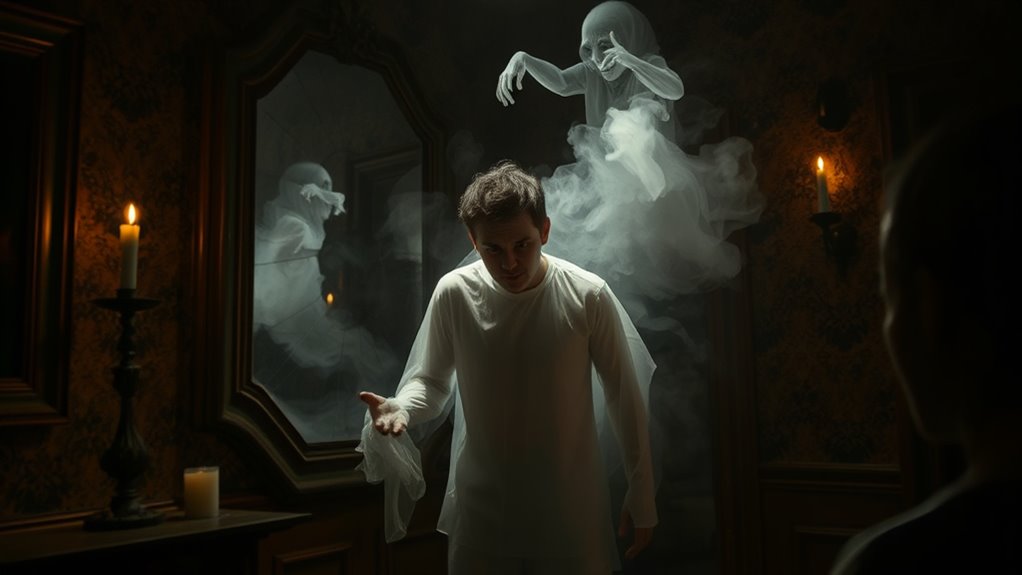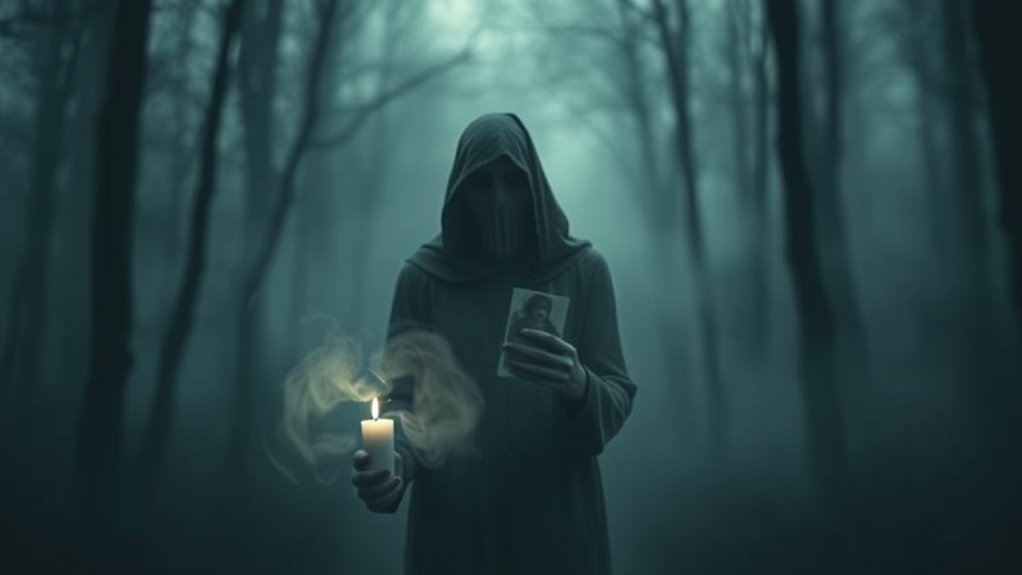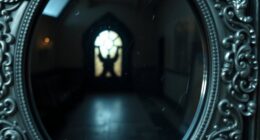Your mind plays a central role in shaping ghost sightings, blending cultural beliefs, expectations, and environmental cues. Factors like sleep paralysis, nightmares, and sensory deprivation can create vivid hallucinations, while psychological traits such as suggestibility and anxiety make you more prone to perceive the supernatural. Your perception is also influenced by cognitive biases and pattern recognition, filling in gaps with familiar shapes or sounds. Curious to see how your brain’s functions influence these haunting experiences? Keep exploring to uncover the full story.
Key Takeaways
- Perception of ghosts is heavily influenced by cultural beliefs, environmental factors, and visual illusions that distort reality.
- Psychological traits such as suggestibility, anxiety, and imagination increase susceptibility to paranormal experiences.
- Sleep phenomena like paralysis, nightmares, and hallucinations often mimic ghost sightings, rooted in subconscious fears.
- Expectations shaped by media and personal beliefs can create self-fulfilling perceptions of supernatural encounters.
- Brain processes, environmental cues, and cognitive biases contribute to misinterpretations of ambiguous stimuli as ghosts.
The History of Ghost Sightings Across Cultures

Throughout history, cultures around the world have reported sightings of spirits and ghosts, reflecting deep-rooted beliefs about life after death. Ancient folklore often features spirits as messengers or protectors, embodying cultural symbolism that reinforces moral lessons or societal values. For example, in Chinese tradition, ancestral spirits are honored to guarantee harmony and good fortune, while in Western folklore, ghosts frequently symbolize unresolved guilt or tragedy. These stories serve to connect the living with the dead, shaping cultural identity and spiritual practices. You can see how these beliefs influence rituals, art, and storytelling, creating a shared understanding of what happens after death. Additionally, asset division laws and practices often reflect the importance of cultural values and legal frameworks that have evolved over time. cultural symbolism plays a significant role in shaping perceptions of spirits and the afterlife across different societies. Such widespread reports highlight the enduring human fascination with spirits, rooted in cultural storytelling and ancient traditions. The persistent nature of these reports also emphasizes the importance of cultural beliefs in maintaining societal cohesion and continuity. Moreover, these beliefs often influence funerary customs, reinforcing the connection between cultural identity and spiritual beliefs.
How Perception Shapes Paranormal Experiences

Have you ever wondered why two people can witness the same supposed paranormal event and interpret it so differently? Your visual perception plays a vital role in shaping these experiences. Your brain processes ambiguous stimuli, often influenced by cognitive illusions, which can distort reality. These illusions make you see or interpret things that aren’t really there, heightening the impression of paranormal activity. Your mind fills in gaps or misreads shadows, sounds, and movements, creating vivid but false impressions. Factors like lighting, environmental cues, and personal beliefs amplify this effect. Understanding how perception influences these encounters helps explain why ghost sightings vary so much from person to person. Additionally, filter maintenance plays a crucial role in ensuring consistent air quality, just as accurate perception influences the authenticity of paranormal experiences. Proper environmental controls can reduce misperceptions caused by external factors. Recognizing the influence of narcissistic tendencies can also shed light on how certain individuals might manipulate or distort perceptions during such events. Furthermore, cultural differences in Halloween celebrations around the world can shape collective perceptions and interpretations of spooky phenomena.
The Role of Suggestibility and Expectation

Your expectations and suggestibility can heavily influence how you interpret paranormal encounters. If you’ve grown up surrounded by stories of ghosts, media influence can prime your mind to see or hear things that fit those narratives. Cultural symbolism also shapes what you might perceive, as certain symbols or patterns are linked to spirits or hauntings in your culture. When you’re in a setting with little physical evidence, your mind fills in gaps based on what you expect to see. This mental framing increases suggestibility, making you more likely to interpret ambiguous stimuli—like creaks or shadows—as paranormal. Additionally, perceptual biases can cause individuals to focus on certain stimuli over others, further reinforcing these perceptions. Your beliefs, reinforced by media and cultural cues, can create a self-fulfilling prophecy, turning ordinary experiences into ghostly encounters. Moreover, the psychological effects of expectation can lead people to perceive phenomena that aren’t actually present, heightening the sense of paranormal activity. Recognizing how confirmation bias influences perception can help individuals distinguish between actual phenomena and psychological effects. A deeper understanding of cognitive biases involved in perception can aid in developing a more objective view of such experiences. Engaging in practices like mindfulness and stillness can help individuals recognize these biases and develop a clearer understanding of their perceptions.
Sleep Paralysis and Nightmares as Ghostly Encounters

When you experience sleep paralysis, you might feel a heavy presence or see shadowy figures, blurring the line between reality and the supernatural. Nightmare hallucinations can reinforce these ghostly encounters, making them seem utterly real. Psychological triggers like stress or trauma often set the stage for these unsettling events to occur. Additionally, analyzing customer sentiment through AI can help identify underlying stressors or emotional states that contribute to these experiences. Understanding the psychological aspects of sleep paralysis can shed light on why such vivid and frightening images occur during these episodes.
Sleep Paralysis Experiences
Sleep paralysis often feels like a terrifying encounter with the supernatural, blurring the line between dreams and reality. During these episodes, you might see shadowy figures or feel a heavy presence, making it seem like ghostly entities are nearby. Factors like sleep deprivation or attempts at lucid dreaming can increase your vulnerability to these experiences. Your mind, overwhelmed and exhausted, creates vivid hallucinations that seem real. These episodes can leave you feeling shaken or scared, especially when the boundary of what’s real is so blurred. Recognizing that sleep paralysis is a common, temporary phenomenon helps demystify these frightening moments. By understanding its connection to your sleep habits, you regain control and reduce the fear associated with these supernatural-like encounters.
- Sleep deprivation heightens hallucination intensity
- Lucid dreaming can trigger sleep paralysis episodes
- Recognizing sleep paralysis reduces fear and anxiety
Nightmare Hallucinations
Have you ever woken up from a nightmare only to feel a lingering sense of dread, as if the ghostly figures from your dreams are still present? Nightmares and sleep paralysis can blur the line between reality and hallucination, making you question what’s real. During these episodes, your mind might enter a state similar to lucid dreaming, where you’re aware but unable to move, heightening the sense of fear. Sensory deprivation, like darkness or silence in your environment, can intensify these feelings, causing vivid hallucinations that mimic ghostly encounters. These experiences tap into our subconscious fears, making it easy to mistake hallucinations for supernatural phenomena. Understanding this link between nightmares, sleep paralysis, and sensory deprivation helps explain why so many believe they’ve encountered ghosts during these haunting moments.
Psychological Triggers
Psychological triggers like sleep paralysis and nightmares often create vivid, ghostly encounters that feel real, even though they stem from your mind. During sleep paralysis, your body is temporarily unable to move, and many people report seeing shadowy figures or feeling a presence—experiences that mimic paranormal encounters. Nightmares can also produce intense sensations and visuals that seem to linger, blurring the line between dreams and reality. While paranormal skepticism questions these experiences as genuine hauntings, scientific explanations attribute them to brain processes and stress. Understanding these triggers helps demystify such sightings by revealing how your mind can generate convincing supernatural scenes.
- Brain’s role in vivid hallucinations during sleep
- How stress influences nightmare content
- The importance of scientific explanations over paranormal beliefs
Cognitive Biases That Influence Belief in Spirits

You may notice that once you believe in spirits, you tend to see confirming evidence everywhere. Your brain naturally seeks patterns, making ambiguous events seem meaningful. These cognitive biases can strongly shape your perception of supernatural experiences.
Confirmation Bias Effects
Confirmation bias plays a significant role in shaping beliefs about spirits by leading people to interpret ambiguous experiences as validation of their existing ideas. When you experience visual illusions or sensory deprivation, your mind seeks familiar patterns, making you more likely to interpret strange sensations as ghostly encounters. This bias causes you to focus on evidence supporting your beliefs while dismissing contradictory information. For example, if you already believe in spirits, you might see shadows or hear sounds that confirm your suspicions. Your brain’s tendency to fill in gaps amplifies these perceptions, reinforcing your conviction. Understanding this bias helps you realize that many ghost sightings could stem from your mind’s attempt to make sense of ambiguous stimuli.
- Visual illusions trick your perception into seeing shapes that aren’t there
- Sensory deprivation heightens your sensitivity to minor stimuli, leading to false perceptions
- Confirmation bias causes you to remember only experiences that support your beliefs
Pattern Recognition Tendencies
Pattern recognition is a powerful cognitive tendency that causes the mind to find familiar shapes and sequences even when none exist. This natural ability, known as visual pattern recognition, helps us make sense of complex environments quickly. However, it can also lead to cognitive bias, where you interpret ambiguous images or sounds as meaningful, often in line with your beliefs. For example, you might see a shadow and immediately think it’s a ghost, simply because your brain is trying to connect dots. This tendency makes you more prone to perceiving spirits in vague or random stimuli. Recognizing this bias helps you understand why your mind might assign supernatural significance to ordinary occurrences, fueling belief in spirits even when no actual evidence is present.
The Impact of Trauma and Grief on Ghostly Visions

Trauma and grief often shape the appearance and frequency of ghostly visions, acting as emotional catalysts that manifest in spectral encounters. When you’re overwhelmed by intense emotions, embodied cognition can influence how your mind interprets these feelings, sometimes creating vivid images of spirits or loved ones. Emotional contagion spreads these feelings, making you more susceptible to ghostly visions during times of sorrow or distress. Your subconscious may project unresolved emotions, leading to these spectral experiences. Recognizing how trauma and grief influence perception helps you understand that such visions aren’t always supernatural—they can reflect your emotional state. By addressing underlying emotions, you may find these ghostly encounters diminish or become less distressing. Ultimately, your psychological landscape shapes what you see and experience in moments of vulnerability.
- Emotions act as triggers for spectral visions.
- Embodied cognition links physical sensations to perceptions.
- Emotional contagion amplifies feelings, intensifying ghost sightings.
Hallucinations and Their Connection to Mental Health

Have you ever experienced seeing something that others couldn’t? That’s often linked to hallucinations, which can include auditory ones—hearing sounds or voices no one else perceives. These experiences are common in dissociative states, where your sense of reality feels disconnected or unreal. Mental health conditions like schizophrenia, severe anxiety, or depression can trigger such hallucinations, making you perceive things that aren’t there. Sometimes, these visions or sounds are mistaken for ghostly encounters, but they stem from your brain’s altered perception. Recognizing that hallucinations are connected to mental health helps you understand that these experiences aren’t supernatural but rather symptoms of underlying psychological issues. Addressing these conditions with professional help can reduce or eliminate such distressing perceptions.
Environmental Factors and Their Effect on Perception

Environmental factors can profoundly influence what you perceive, often blurring the line between reality and illusion. Ambient noise, like distant footsteps or creaking floors, can trigger feelings of unease or the sense of a presence. Urban legends, with their eerie stories, shape your expectations and heighten sensitivity to strange sounds or sights. Poor lighting and unfamiliar surroundings also distort perception, making ordinary shadows appear supernatural. These elements combine to create a psychological environment where ghost sightings seem more believable. Recognizing how such factors influence your mind helps you understand why you might interpret normal stimuli as paranormal. Being aware of these influences can help you differentiate between genuine perceptions and those shaped by your environment.
The Psychology of Fear and Its Amplification of the Unknown

Fear acts as a powerful lens that magnifies the unknown, making ordinary shadows or sounds seem far more sinister. Your mind’s fear conditioning amplifies this effect, linking ambiguous stimuli to danger based on past experiences or cultural influences. Sensory distortion also plays a role, as fear heightens your senses, causing normal sensations to seem more intense or unusual. When you’re afraid, your brain overreacts to small cues, filling gaps with imagined threats. This heightened state makes you more likely to interpret harmless events as paranormal. By understanding how fear shapes perception, you realize that your mind’s response to the unfamiliar isn’t always rooted in reality. Instead, it’s driven by an instinct to protect, which often distorts the true nature of what you’re experiencing.
Why Some People Are More Susceptible to Paranormal Experiences

Some individuals are naturally more prone to experiencing the paranormal because their brains process fear and ambiguity differently. Neuroscience research shows that certain personality traits, like high openness or suggestibility, make you more receptive to paranormal stimuli. Your brain’s wiring can amplify perceptions of ghostly encounters, especially when you’re prone to imagining or interpreting ambiguous cues as supernatural. Factors such as heightened imagination, anxiety levels, and a tendency toward fantasy influence susceptibility.
- People with high openness are more likely to interpret ambiguous stimuli as paranormal.
- Suggestible individuals may experience stronger illusions during spooky situations.
- Anxiety can increase the likelihood of perceiving supernatural presence.
Understanding these traits helps explain why some are more receptive to ghost sightings than others.
Frequently Asked Questions
Can Mental Health Disorders Cause Ghost Sightings?
Mental health disorders can indeed cause ghost sightings. Conditions like psychosis can lead to hallucinations, making you see or hear things that aren’t real. Sleep paralysis is another factor, where you might experience vivid, ghostly visions while unable to move. These experiences are rooted in your brain’s altered states, and understanding this can help you recognize that such sightings aren’t supernatural, but psychological phenomena.
How Do Cultural Beliefs Influence Ghost Encounter Reports?
Imagine your mind is a canvas painted by cultural narratives and belief systems, shaping what you perceive. When you encounter reports of ghosts, these cultural influences guide your interpretation, making sightings feel real. Beliefs about spirits, the afterlife, or supernatural forces influence how people report encounters. So, your cultural background acts like a lens, coloring your perceptions and shaping how you interpret mysterious experiences.
Are Children More Likely to See Spirits Than Adults?
You might notice children are more likely to see spirits because of their vivid childhood perceptions and developing cognitive stages. During early developmental stages, their imaginations are more active, making it easier for them to interpret ambiguous stimuli as supernatural. As they grow older, their ability to differentiate reality from fantasy improves, often reducing ghost sightings. So, your child’s encounters could stem from their unique perception and stage of psychological development.
What Neurological Factors Contribute to Paranormal Experiences?
Imagine your mind as a lighthouse, guiding your perceptions through foggy seas. When you experience paranormal events, your brain activity and sensory processing play a big role. These neurological factors can cause your brain to interpret normal stimuli as supernatural. Variations in neural responses, especially in areas controlling perception, make you more susceptible to these eerie experiences. Your brain’s wiring shapes what you believe you see beyond ordinary reality.
Do Environmental Toxins Impact Perception of Ghosts?
Environmental toxins can substantially impact your perception of ghosts by causing sensory impairment. Exposure to certain toxins may alter your brain’s processing, making you more prone to hallucinations or vivid illusions. These chemical influences can distort reality, leading you to interpret normal sensory experiences as paranormal. So, if you’re in an environment with high toxin levels, it’s possible that your perception of ghosts is heightened or misinterpreted due to these neurological effects.
Conclusion
Ultimately, your mind is a powerful playground where perception and belief collide, creating ghostly illusions even when no spirits are present. Your susceptibility to these experiences can turn simple shadows into supernatural encounters—more convincing than a blockbuster thriller. Remember, it’s your brain’s way of interpreting the unknown, making every whisper of the wind feel like a haunted secret. So, next time you sense a ghost, consider it’s just your mind’s extraordinary, spooky craftsmanship at work.









